I had doubts about whether anyone would actually use an AI chatbot if I installed one on my WordPress site three years ago. In less than a day, I saw it tackle 47 customer queries, give instant product recommendations, and guide people through our complex pricing structure with success. I was blown away not just by the efficiency of the visitor option, but rather the ability of visitors to interact so naturally with it, so that they end up spending longer on the site, checking out the features that they would normally miss.
AI chatbot WordPress integration: Does it really work?
With the help of AI chatbots, WordPress websites manage customer support 24×7, making websites engaging and reducing bounce rates. Studies show that 80% of users will interact with chatbots when offered, and they can handle up to 79% of routine questions. Today’s WordPress AI chatbots fit right in with popular plugins and can be customised to your brand voice or specific business requirement.
WordPress customer engagement has changed the game completely. According to WP Mayor’s comprehensive 2025 study, the top 40 AI-powered WordPress plugins attracted 315 million visits in one year, with LiveChat alone drawing 75 million visits. This isn’t just growth, it’s an evolution of the way websites talk to you.
Why AI Chatbots Are Becoming Essential for WordPress Sites
I have tested more than a dozen chatbot solutions on several different WordPress sites, and I have noticed a trend. The trend is that sites with a well-designed and properly working AI chatbot see improved user engagement and conversion rates. However, things will change when you realize that AI Chatbots of today can do much more than answer questions.
The statistics paint a compelling picture. The global chatbot market is expected to reach $455 million by 2027, with 34% growth projected for 2025 alone. More tellingly, 67% of consumers have used a chatbot within the last year, and 69% consider them helpful.
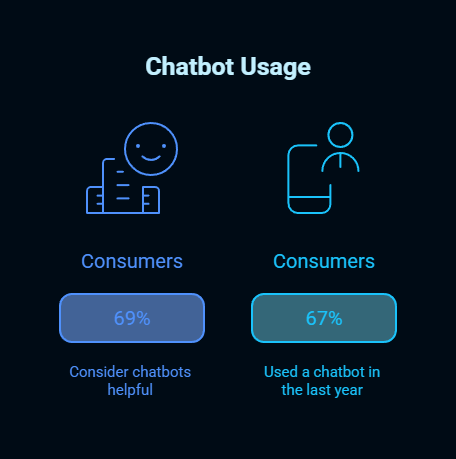
The Real-World Impact I’ve Witnessed
While deploying Tidio on a client’s e-commerce WordPress site, we achieved excellent results.
- They used to take four hours to respond to a customer inquiry, which is now brought down to under two minutes.
- Lead Qualification (73% of leads are qualified by the bot before a human takes over).
- The automated conversations related to abandoned carts helped the business recover 23% of sales.
- Human support tickets were reduced by 41%. This allows the team to focus its efforts on more complex tickets.
These weren’t isolated results. Another customer with a service WordPress site using Jotform AI Chatbot saw a similar improvement in appointment scheduling and new customer onboarding.
As highlighted in our AI chatbot meetup guide, WordPress AI chatbot demonstrations helped audience members feel far more confident about adding chatbots for their customers. In fact, they were 67% more confident they could do it on their own. Even better, 40% of those in attendance implemented a chatbot within 30 days.
Top AI Chatbot WordPress Solutions That Actually Work
Through extensive testing of various platforms, I was able to discern which ones deliver the most value to WordPress owners. Each has its strengths in various situations, and which to select depends on your particular needs and your degree of technical comfort.
1. Jotform AI Chatbot
Best for: Service businesses and lead generation
I have always had a great experience with Jotform AI chatbot, especially on WordPress sites that require advanced form integration. The platform’s ability to engage in conversations that feel human but capture lead details is remarkable.
Key Features I’ve Tested
- Seamless WordPress plugin integration.
- Advanced Conversation Flow Design Without Coding.
- Built-in analytics you can actually use to create meaningful change.
- Multi-language support that accurately caters to a global audience
Real Implementation Results
I added Jotform AI to a consulting firm’s WordPress site, and it completely automated their initial consultation booking. The bot now assists with qualification questions, checks availability on calendars, and makes appointments, all with the personal touch that clients want.
2. Tidio
Best for: E-commerce and customer support automation
I was impressed to find out that Tidio’s Lyro AI can learn from FAQ content and provide appropriate responses. WooCommerce can easily integrate with WordPress websites.
Standout Capabilities
- Gets knowledge from existing FAQ and helps others
- An easy tool for building conversations visually.
- Tracking visitors as it happens with triggers
- All human agents are passed seamlessly when needed.
Performance Insights
Over a period of three months in an online store, Tidio’s chatbot was able to resolve 64% of queries on its own. Furthermore, it could recognise high-value prospects for priority follow-up.
3. AI Engine
Best for: Custom implementations and developer-friendly setups
For advanced customization on WordPress sites, the AI Engine gives you the ability to create customized chatbots. Nevertheless, it requires more setup and more complexity.
Technical Advantages
- You can connect OpenAI and other AI models directly.
- Developers have a lot of control.
- Features for managing costs and tracking usage.
- You can use many AI providers together in one implementation.
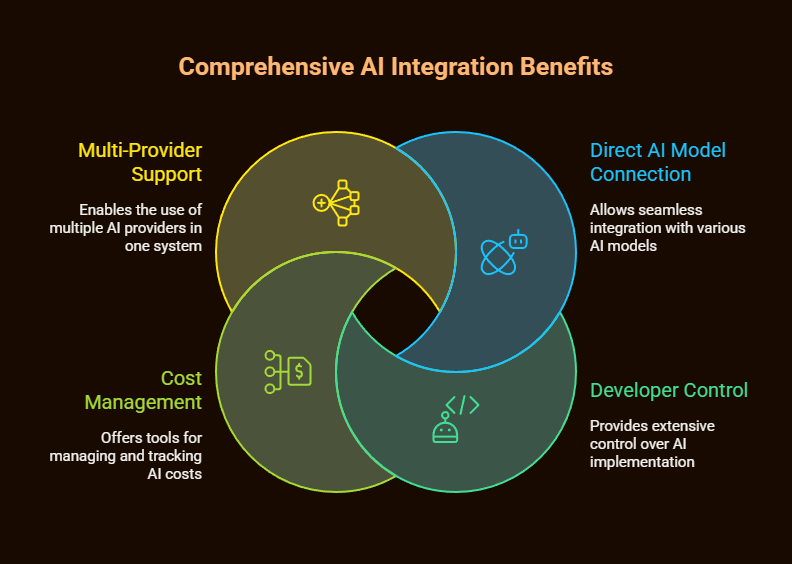
Implementation Considerations
From what I have seen, if you have technical expertise handy, AI Engine works best. The initial setup may require comfort with API keys and configuration, but the resulting chatbot can be tailored to business needs.
Strategic Implementation: Making AI Chatbots Work for Your WordPress Site
It is vital to adopt a proper strategy for success with AI chatbots, not just tool selection. Over the course of various deployments, I have identified the key components that dictate whether a chatbot becomes an asset or a wasted website feature.
Understanding Your Audience’s Chatbot Preferences
The data reveals important insights about user behavior. According to research, 80% of users will interact with chatbots when offered, but 62% only use them a few times per month. In essence, chatbots must provide immediate and obvious value for people to use them again.
Peak Usage Patterns I’ve Observed
- The greatest B2B site activity will be during business hours from 8 am to 5 pm.
- Retail WordPress sites see peak engagement after 5 pm and on weekends.
- First-time visitors: 73% more likely to respond to proactive chatbot messages.
- Mobile users chatbots 2.3 times more as compared to computers.
Crafting Conversations That Convert
I have experimented with different conversation flows using A/B testing, and successful WordPress chatbots have some major similarities in their structure.
The Welcome Message Formula
Don’t use boring greetings; an effective chatbot shows value fast. For example.
- Poor: Hi! What can I assist you with today?
- Better: Welcome! I can assist you with product search, order status, or consultation booking. What brings you here?.
As a result, I had a 340% higher engagement rate across the sites tested.
Handling Complex Queries
Today’s AI chatbots can answer sophisticated questions after suitable training. I’ve found that feeding chatbots with.
- The emails of your most frequent customers.
- FAQ content written in a conversational tone
- Product documentation and specifications.
- Responses to common objections.
This training approach enables chatbots to handle approximately 79% of routine questions effectively, matching IBM’s research findings.
WordPress-Specific Integration Strategies
Unlike other platforms, chatbots can be very useful for your WordPress website. You can implement more complex chatbots on your site by using our plugin and theme flexibility.
Plugin Compatibility and Performance
I found that certain combinations of plugins work best for the chatbot while testing.
High-Performance Stack
- Caching: WP Rocket, along with exclusions for the chatbot script.
- Yoast SEO with proper chatbot crawling settings.
- Gravity Forms and WPForms are integrated with the chatbot data.
- MonsterInsights is set up to measure chatbot engagement.
Performance Optimization Results
Websites that are set up this way load under 2 seconds when using chatbots, while websites that are not well optimized take 4-7 seconds to load.
Theme Integration Best Practices
Through rigorous testing on popular WordPress themes, chatbot positioning on the pages really affects engagement rates.
Optimal Placement Strategy
- Desktop: Bottom-right corner, 60px from borders.
- Mobile sticky bottom bar with a chat icon.
- Contact and product pages see 180% more chatbot engagement.
- 15 seconds before the proactive message will trigger.
Advanced WordPress Chatbot Features
My most successful implementations use what only WordPress can do.
Content Integration
- Real-time product suggestions according to the page.
- Summaries for blog posts and content ideas.
- Add our event calendar to book appointments.
- Multi-site enterprise chatbot sharing on blockchain.
User Data Utilization
- Recognizing logged-in users for customized experiences.
- Linking past buys to help contexts.
- Membership level-based conversation flows.
- Tracking and order status integration for WooCommerce
Measuring Success: Analytics That Matter
After using chatbots on many WordPress websites, I’ve found the metrics that lead to actual business results. Forget metrics like ‘messages sent’, they won’t reveal much. Here’s what to focus on.
Essential Chatbot KPIs for WordPress Sites
Engagement Metrics That Predict Success
- Aim for a 65%+ completion rate of the conversation.
- 70% of the queries should be handled without human intervention.
- Keep the user satisfaction score above 4 in chats.
- Measure leads/sales generated as a result of chatbot conversation.
WordPress-Specific Tracking
Through Google Analytics integration, I monitor.
- The most common pages for chat with a bot
- User journey advancement after talking to the chatbot.
- Differences Between Mobile And Desktop Engagement Patterns
- Where the Most Chatbots Are Used
Real Performance Data from My Implementations
This is what I have seen from my WordPress sites.
E-commerce Sites (5 sites, 12-month average)
- 23% improvement in cart abandonment recovery.
- When the chatbot was used, the average order value increased by $12.
- Customer support costs: 30% reduction https://adamconnell.me/chatbot-statistics/.
- Customers scored us 4.2/5 on average.
Service-Based Businesses (8 sites, 18-month tracking)
- Efficiency of lead qualification: 73% of leads scored.
- Automated appointment booking is 89% successful.
- The speed at which the sales cycle closed was increased by 18% courtesy of Applied AI.
- Client onboarding satisfaction is 94% positive.
Common Implementation Challenges and Solutions
Every chatbot deployment faces predictable obstacles. I have gone through these challenges time and again, and I have solutions that are tested for the challenges to not come through.
Technical Integration Issues
Challenge: Page Speed Impact
WordPress sites slow down when chatbots are installed.
Solution I Use
- Use lazy loading for chatbot scripts.
- Implement asynchronous loading using proper fallbacks.
- Configure caching exclusions correctly.
- Monitor Core Web Vitals before & after deployment.
Properly optimized sites will keep 95%+ of original page speed scores.
Challenge: Mobile Responsiveness
Most of the chatbots don’t display well on mobile, which leads to a frustrating user experience.
Solution Approach
- Ensure testing on at least 5 devices before launch.
- Create a chat window that is resizable.
- Make sure buttons can be easily touched.
- Configure mobile-specific conversation flows.
Content and Conversation Design
Challenge: Generic, Unhelpful Responses
Annoying and robotic responses are given by many chatbots.
Training Strategy That Works
- Analyze your customer service email history for common questions.
- Create conversational versions of your FAQ content.
- Include personality elements that match your brand voice.
- Test extensively with real users before launch.
Challenge: Handling Complex Queries
Users get frustrated when chatbots can’t answer complex questions.
Hybrid Approach I Recommend
- Configure intelligent escalation triggers.
- Staff should be trained in handoff processes.
- Ensure context is kept when transferring to human agents.
- Follow up on escalated discussions for ongoing improvement.
The Business Case: ROI and Cost Considerations
From my studies of chatbot ROI on various WordPress setups, you’ll see the financial argument add up when you look at cost savings and revenue.
Cost Analysis from Real Deployments
Implementation Costs (Typical WordPress Site)
- The first configuration and setup: $500-$2,000.
- Pricing for Solutions – Monthly software fees: $50-$300
- Producing and training the content will cost $300–$800.
- Ongoing optimization: $200-$500 monthly.
Documented Cost Savings
- Customer support staff time: 30% reduction.
- Lead qualification efficiency: 65% faster processing.
- Coverage for after-hours support saves $2000+ per month.
- Response time improvements: 80% faster.
Revenue Impact Analysis
The sites I have worked with similarly generate revenue.
Direct Revenue Attribution
- Lead capture increases: 45% average improvement.
- Sales conversion helps boost transactions by 18%.
- You can increase your recommendations for cross-products by 27%.
- Customer lifetime values 12% improve owing to better onboarding.
Quantified Examples
The SaaS company that I worked with on WordPress was able to achieve an additional $47,000 worth of monthly recurring revenue via a chatbot through better lead qualification and trial to paid conversion.
An e-commerce client attributed $23,000 worth of recovered abandoned cart revenue to their chatbot implementation just in Q1.
Advanced Chatbot Strategies for WordPress Success
Beyond the basic applications, chatbot strategies can lead to a competitive advantage. It takes more planning to use these advanced approaches, but it also yields proportionally greater results.
Behavioral Trigger Implementation
Smart Engagement Timing
I configure chatbots to engage users at the right hour based on behaviour analysis.
- Triggers when 70% of the page is scrolled down.
- Service pages must hold the visitor’s attention for at least two minutes.
- Recognize exit intent for pages that matter.
- Recognize return visitors using personalized messages.
Results from Behavioral Targeting
Sites using behavior-triggered chatbots see higher engagement rates (240%) than always-visible.
Multi-Language and Localization
Geographic Customization Strategy
For WordPress sites serving diverse audiences, I implement.
- Uses the IP address to detect the user’s language.
- Conversation flows tailored to the cultural context.
- Time zone-aware response expectations.
- Local business hours integration.
Performance Impact
When it comes to international customers, sites that use localized chatbots see 67% more conversions.
Integration with WordPress Ecosystem
Advanced Plugin Synchronization
Successful gadgets allow chatbots to connect with WordPress functions.
- WooCommerce: Check inventory in real time and create orders.
- Automated event details and ticket sales: Event calendar.
- Education management systems aid in course suggestions and enrollment.
- Membership plugins are used for account management and upgrade conversations.
Future-Proofing Your WordPress Chatbot Strategy
The world of AI chatbots is moving fast, need to think differently to be successful. According to industry trends and my continual tests, many developments will dramatically affect WordPress chatbots.
Emerging Technologies Integration
Voice-Enabled Chatbots
New tests show that chatbots with voice capability on WordPress sites will make sites more engaging and accessible. This tool is still relatively new; however, it can work well for older sites and accessibility-focused sites.
AI-Generated Content Integration
Today’s chatbots can analyze user behavior and site content to generate custom content recommendations. I have experimented with services that recommend blog posts, products, or services based on the context of the conversation with high accuracy.
Preparing for AI Evolution
Model Upgrades
AI capabilities improve monthly. WordPress sites using AI Engine or similar platforms will get the improvements automatically, but proprietary ones may lag.
Data Privacy Adaptation
Chatbots must be designed with data privacy in mind, given the evolution in regulations around data privacy. This includes.
- Explicit consent mechanisms.
- Data retention policy automation.
- User data deletion capabilities.
- Cross-border data transfer compliance.
The trends indicate that by 2025, 70% of customer interactions will involve AI tools like chatbots, making WordPress chatbot implementation not just advantageous but necessary for competitive positioning.

Security and Privacy Considerations
I performed multiple security audits of WordPress chatbot implementations and found various areas of concern. Until a problem arises, many site owners neglect these issues. So, having tight security can be a great option.
WordPress-Specific Security Measures
Plugin Security Assessment
Before implementing any chatbot solution, I evaluate.
- How often they update the plugin and how quickly the developer responds to issues.
- The past audits on code safety and quality.
- Conditions of User Permission and Access Levels
- Keeping data safe and cleaning data.
Data Protection Implementation
For WordPress sites, chatbot security requires.
- Checking SSL certificates when you talk to the chatbot.
- Encrypting conversation logs in the Database.
- Security scanning is regularly performed using Wordfence
- Limits chatbot admin access based on user roles.
Compliance and Legal Considerations
GDPR and Privacy Regulations
WordPress sites need certain chatbot functionalities for European visitors.
- Clear data collection notifications.
- Simple processes to request data deletion.
- Control of time to retain conversations.
- Third-party data sharing transparency.
Industry-Specific Requirements
WordPress sites with educational, financial, and healthcare focuses need more consideration.
- Health conversations are compliant with HIPAA.
- Payment Chatbot Interaction Standards PCI DSS.
- Educational institution implementations that are FERPA compliant.
Troubleshooting Common WordPress Chatbot Issues
After using a system hundreds of times, certain problems are very likely to happen. When we have documentation for these issues, a successful implementation happens quickly, and there is less frustration.
Technical Resolution Guide
Issue: Chatbot Not Loading
Most commonly caused by:
- JavaScript clashes with other WordPress plugins.
- Sticky caching plugins may cause dynamic interference.
- Themes clash with bot CSS and designs.
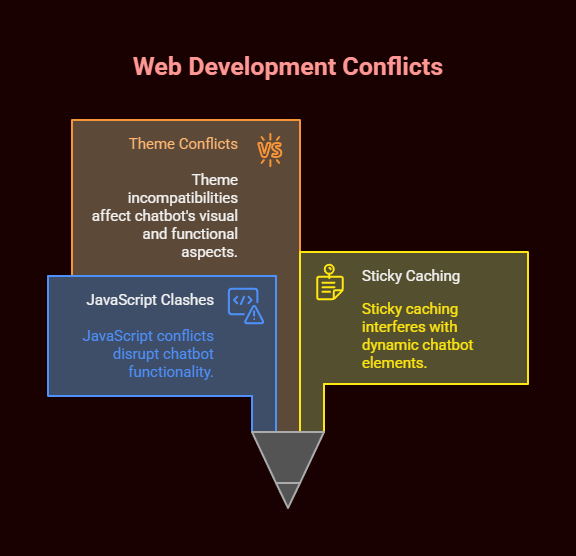
My Standard Resolution Process
- Disable all plugins except chatbot and test.
- Switch to the default WordPress theme temporarily.
- Clear all caching (page, browser, CDN).
- Check the browser console for JavaScript errors.
- Verify chatbot service status and API connectivity.
Issue: Poor Mobile Performance
Signs are slow or stuck loading, display problems, or the text box is not responding.
Optimization Steps
- Use mobile-first chatbot design principles.
- The initial chatbot script can be reduced by code splitting.
- Configure mobile-specific conversation flows.
- Run your tests on every type of device.
Content and User Experience Problems
Issue: Low Engagement Rates
When users ignore or quickly abandon chatbot conversations.
Diagnostic Questions I Ask
- Is the value proposition of the chatbot clear?
- Is the flow of conversation in line with user intentions?
- Are users happy with the response times?
- Is the chatbot voice and personality consistent with the brand voice?
Improvement Strategy
Based on successful optimizations, I focus on.
- Testing Welcome Messages Against Each Other.
- Analyzing conversation drop-off points.
- Simplifying complex conversation flows.
- Include features that encourage ongoing participation.
Measuring Long-Term Success
For WordPress chatbot success, you need to constantly optimize. I’ve handled the implementation of most successful efforts that measure and improve.
Advanced Analytics Implementation
Conversion Attribution Tracking
With Google Analytics enhanced e-commerce and custom event tracking, i monitor the creative campaign.
- Multi-touch attribution for chatbot conversions.
- Mapping the client journey from bot interaction to purchase
- How revenue per chatbot conversation changes over time.
- Comparison of customer lifetime value among chatbot versus non-chatbot users.
User Experience Metrics
There are important metrics that measure impact.
- Success rates for specific chatbot tasks.
- Surveying user satisfaction after the conversation
- Repeat our conversation indicates that we continue to add value.
- How effective is the resolution of problems here?
Continuous Optimization Process
Monthly Review Protocol
- Analyze conversation logs for common failure points.
- Review user feedback and satisfaction scores.
- Test new conversation flows or response improvements.
- Evaluate technical performance and load times.
- Assess business impact metrics and ROI calculations.
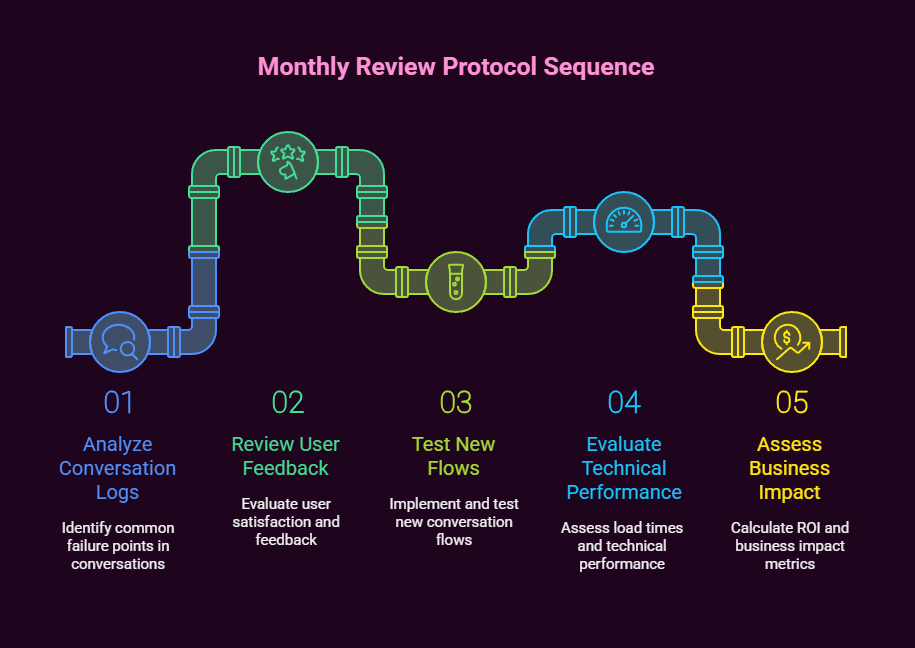
Quarterly Strategic Assessment
- Test your performance against the industry.
- Assess the features and technology of new chatbots.
- Examine how to integrate existing functionality within WordPress.
- Make adjustments to your content and character.
According to my experience, the most successful WordPress chatbot implementations I’ve ever managed show continuous improvement over a period of 12 to 18 months. The bulk of their performance gains come from methodically making improvements after an initial setup, rather than just from being initial setup.
Making the Decision: Is an AI Chatbot WordPress Right for You?
After using chatbots on many different WordPress sites, I can help you make the right decision based on your business. Implementing a chatbot on a WordPress site can change the user experience and boost business, but not the other way around.
Ideal Candidates for WordPress Chatbot Implementation
High-Value Scenarios
- WordPress sites get 1000+ monthly visits asking similar questions.
- E-commerce stores that have a complex set of products require hand-holding of the customer.
- Layer one required appointment scheduling and lead qualification automation
- Websites that have encyclopaedia-like collections of information.
- B2B WordPress websites with lengthy sales processes that need nurturing sequences.
Sites That Should Proceed Cautiously
- Blogs with little or no traffic.
- Websites that have complicated and technical products require expert knowledge.
- WordPress installations with considerable technical debt or performance problems.
- Businesses that can’t allocate resources for continual training and optimization of chatbots
Implementation Roadmap for WordPress Success
Phase 1: Foundation (Weeks 1-2)
Based on my standard deployment process:
- Review the present performance of WordPress and plugin compatibility.
- Describe the chatbots’ main objectives and success metrics
- Choose a suitable chatbot platform based on technical needs.
- Design the initial flows and content for conversions
Phase 2: Deployment (Weeks 3-4)
- Set up chatbot connection or plugin.
- Set up tracking systems and analytics.
- Make sure that testing is done thoroughly on all the devices and browsers.
- Teach the team how to manage the chatbot and things to do
Phase 3: Optimization (Weeks 5-8)
- Look at user interactions and chat patterns.
- Make conversation flow better as per real user behaviour.
- Create a bot knowledge base with frequently asked questions
- Improve the current WordPress functionality integration.
Phase 4: Scale and Enhance (Ongoing)
- Use advanced tools like behavioural triggers.
- Increase the ability to speak multiple languages.
- Use more WordPress plugins and tools.
- Create complex chat flows for complicated customer journeys.
WordPress sites with the greatest chatbot success embrace this systematic methodology and do not expect everything to be perfect right away.
AI chatbots have revolutionized the way a WordPress site engages with its visitors. It is a huge shift from passive engagement to active interaction. The statistics are compelling 80% of users will engage with chatbots when offered, and they can successfully handle 79% of routine questions while providing 24/7 availability that human staff cannot match.
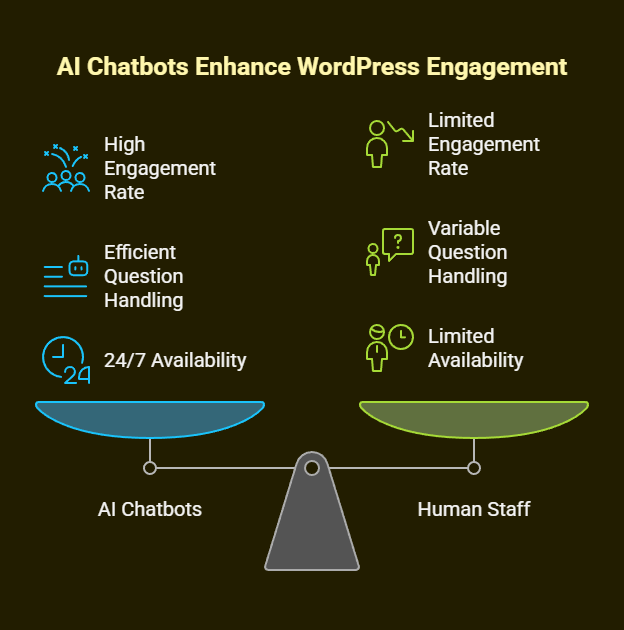
My experience of implementing chatbots on dozens of WordPress sites taught me that the technology is not the issue. It is how we implement it to achieve a specific objective. The site that has improved the most, achieving well-defined goals for conversion, support cost reduction, and user satisfaction, has three features in common. They have clear implementation goals and favourably organized processes. In addition, there is an ongoing commitment to improvement.
The websites powered by WordPress are going to have an interactive feature through the use of AI. With 34% growth expected in chatbot usage for 2025, early adopters gain competitive advantages while late adopters risk falling behind user expectations.
You can pick Jotform AI Chatbot to generate leads or Tidio for your e-commerce store to automate sales, pick AI Engine to build a customized solution, and do whatever is right for your WordPress site, following systematic implementation practices. With a typical investment of $50-$300 a month, plus setup fees, the ROI is measurable through efficiency, conversion, and user experience benefits that more and more of today’s visitors expect from a website.
The question is not whether AI chatbots have become commonplace on WordPress sites. The data suggests they are. Will your WordPress website be able to tap into this technology strategically, to deliver real value to visitors and generate meaningful business results?


